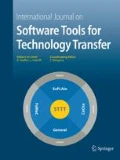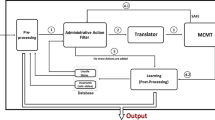Abstract
We explain how a parameterized model checking technique can be exploited to mechanize the analysis of access control policies. The main advantage of the approach is to reason regardless of the number of users of the system in which the policy is enforced. This permits to obtain more useful results from the analysis; for instance, ensuring that sensitive permissions cannot be leaked regardless of the number of users in the system. We also briefly discuss how some heuristics make the technique scalable to handle (very) large policies. This is demonstrated by a comparative experimental evaluation with state-of-the-art tools for the analysis of access control policies.


Similar content being viewed by others
Notes
This definition is different from that in the seminal paper [2] introducing the safety problem. In [2], unsafety is characterized by checking for permission leakages with respect to the policy immediately before the operation leaking the permission and not with respect to the initial policy as above. According to [3], such a notion of permission leakage creates several difficulties and (almost) all works proposing techniques to handle the safety problem have used the one reported above.
We thank Martin Suda for pointing out this example.
We thank the authors of Mohawk, Vac, and Pms for making available to us the latest version of their tools. We also thank the support team of NuSMV for their help with the installation of the tool, a necessary pre-requisite for using Mohawk.
The module \({{\mathtt {Filter}}}\) and the slicing technique in [5] share the goal of removing administrative actions which are irrelevant to the user-role reachability problem under consideration. The hope is to reduce the state space to be explored by the search procedure (in our case, the backward reachability procedure) invoked afterwards. In principle, \({{\mathtt {Filter}}}\) can be used in place of slicing and vice versa; the main difference between the two approaches is the level of “aggressiveness”: the former performs a computationally cheap check for establishing if an action is relevant, whereas the latter is computationally more expensive.
References
De Capitani di Vimercati, S., Foresti, S., Jajodia, S., Samarati, P.: Access control policies and languages. Int J Comput Sci Eng (IJCSE) 3(2), 94–102 (2007)
Harrison, M.A., Ruzzo, W.L., Ullman, J.D.: Protection in operating systems. CACM 19(8), 461–471 (1976)
Tripunitara, M., Li, N.: The foundational work of Harrison–Ruzzo–Ullman revisited. IEEE Trans Depend Sec Comput 10(1), 28–39 (2013)
Armando, A., Ranise, S.: Scalable automated symbolic analysis of administrative role-based access control policies by SMT solving. J Comput Secur 20(4), 309–352 (2012)
Ferrara, A.L., Madhusudan, P., Parlato, G.: Policy analysis for self-administrated role-based access control. In: TACAS. Springer, Berlin (2013)
Sandhu, R., Coyne, E., Feinstein, H., Youmann, C.: Role-based access control models. IEEE Comput 2(29), 38–47 (1996)
Sandhu, R., Bhamidipati, V., Munawer, Q.: The ARBAC97 model for role-based control administration of roles. ACM TISSEC 1(2), 105–135 (1999)
Jayaraman, K., Ganesh, V., Tripunitara, M., Rinard, M., Chapin, S.: Automatic error finding for access-control policies. In: CCS. ACM, New York (2011)
Li, N., Tripunitara, M.V.: Security analysis in role-based access control. ACM TISSEC 9(4), 391–420 (2006)
Stoller, S.D., Yang, P., Ramakrishnan, C.R., Gofman, M.I.: Efficient policy analysis for administrative role based access control. In: CCS. ACM Press, New York (2007)
Yang, P., Gofman, M.l., Stoller, S., Yang, Z.: Policy analysis for administrative role based access control without separate administration. J Comput Secur (2014)
Sasturkar, A., Yang, P., Stoller, S.D., Ramakrishnan, C.R.: Policy analysis for administrative role based access control. In: CSF. IEEE Press, New York (2006)
Abdulla, P.A., Cerans, K., Jonsson, B., Tsay, Y.K.: General decidability theorems for infinite-state systems. In: Proceedings of LICS, pp. 313–321 (1996)
Ghilardi, S., Ranise, S.: Backward reachability of array-based systems by SMT solving: termination and invariant synthesis. In: LMCS, vol. 6, no 4 (2010)
Ghilardi, S., Ranise, S.: MCMT: a model checker modulo theories. In: Proceedings of IJCAR’10. LNCS, New York (2010)
Piskac, R., de Moura, L., Bjørner, N.: Deciding effectively propositional logic using DPLL and substitution sets. J Autom Reas 44(4), 401–424 (2010)
Crampton, J.: Understanding and developing role-based administrative models. In: Proceedings of the 12th CCS. ACM Press, New York, pp. 158–167 (2005)
Sasturkar, A., Yang, P., Stoller, S.D., Ramakrishnan, C.R.: Policy analysis for administrative role based access control. Theor Comput Sci 412(44), 6208–6234 (2011)
Ranise, S.: Symbolic backward reachability with effectively propositional logic-applications to security policy analysis. FMSD 42(1), 24–45 (2013)
Ramsey, F.P.: On a problem of formal logic. Proc Lond Math Soc s2–30(1), 264–286 (1930)
Beckert, B., Hoare, C.A.R., Hähnle, R., Smith, R., Green, D.R., Ranise, S., Tinelli, C., Ball, T., Rajamani, S.K.: Intelligent systems and formal methods in software engineering. IEEE Int Syst 21(6), 71–81 (2006)
Enderton, H.B.: A mathematical introduction to logic. Academic Press Inc, New York (1972)
Alberti, F., Armando, A., Ranise, S.: ASASP: automated symbolic analysis of security policies. In: CADE. LNCS, vol. 6803. Springer, Berlin, pp 26–34 (2011)
Ranise, S., Truong, T.A., Armando, A.: Boosting model checking to analyse large ARBAC policies. In: 8th STM Workshop, LNCS, vol. 7783. Springer, Berlin, pp 273–288 (2012)
Gofman, M.I., Luo, R., Solomon, A.C., Zhang, Y., Yang, P., Stoller, S.D.: Rbac-pat: a policy analysis tool for role based access control. In: TACAS, LNCS, vol. 5505. Springer, Berlin, pp 46–49 (2009)
Li, N., Tripunitara, M.V.: Security analysis in role-based access control. In: Symp. on Access Control Models and Technologies. ACM Press, New York, pp 126–135 (2004)
Jha, S., Li, N., Tripunitara, M., Wang, Q., Winsborough, W.: Towards formal verification of role-based access control policies. IEEE TDSeC 5(4), 242–255 (2008)
Alberti, F., Armando, A., Ranise, S.: Efficient symbolic automated analysis of administrative role based access control policies. In: ASIACCS. ACM Press, New York (2011)
Jayaraman, K., Tripunitara, M.V., Ganesh, V., Rinard, M.C., Chapin, S.J.: Mohawk: abstraction-refinement and bound-estimation for verifying access control policies. ACM TISSeC 15(4) (2013)
Clarke, E.M., Strichman, O., Zhu, Y., Biere, A., Cimatti, A.: Bounded model checking. Adv Comput 58, 117–148 (2003)
Ranise, S., Traverso, R.: ALPS: an action language for policy specification and automated safety analysis. In: STM Workshop, number 8743 in LNCS. Springer, Berlin, pp. 146–161 (2014)
Fikes, Richard E., Nilsson, Nils J.: Strips: a new approach to the application of theorem proving to problem solving. Artif. Intell. 2(3), 189–208 (1972)
Erol, K., Nau, D.S., Subrahmanian, V.S.: Complexity, decidability and undecidability results for domain-independent planning: a detailed analysis. Artif. Intell. 76, 75–88 (1991)
Ranise, S., Truong, A.: Incremental analysis of evolving administrative role based access control policies. In: 28th Annual IFIP WG 11.3 Working Conference DBSeC14, Vienna, Austria, 14-16 July 2014. LNCS, vol 8566. Springer, Berlin, pp. 260–275 (2014)
Gofman, M., Yang, P.: Efficient policy analysis for evolving administrative role based access control. Int J Softw Inf (2014)
Gofman, M.I., Luo, R., Yang, P.: User-role reachability analysis of evolving administrative role based access control. In: ESORICS, vol. 6345. LNCS, Berlin, pp. 455–471 (2010)
Ranise, S., Truong, A., Armando, A.: Scalable and precise automated analysis of administrative temporal role-based access control. In: tACM SACMAT, London, Ontario, Canada, June 25–25 2014. ACM Press, New York, pp. 103–114 (2014)
Uzun, E., Atluri, V., Sural, S., Vaidya, J, Parlato G, Ferrara AL (2012) Analyzing temporal role based access control models. In: SACMAT. ACM, New York, pp. 177–186 (2014)
Ranise, S., Truong, A., Viganò, L.: Automated analysis of RBAC policies with temporal constraints and static role hierarchies. In: 30th ACM/SIGAPP SAC, Salamanca, Spain, April 13–17, 2015. ACM Press, New York (2015)
Author information
Authors and Affiliations
Corresponding author
Rights and permissions
About this article
Cite this article
Ranise, S., Truong, A. & Traverso, R. Parameterized model checking for security policy analysis. Int J Softw Tools Technol Transfer 18, 559–573 (2016). https://doi.org/10.1007/s10009-015-0410-1
Published:
Issue Date:
DOI: https://doi.org/10.1007/s10009-015-0410-1




